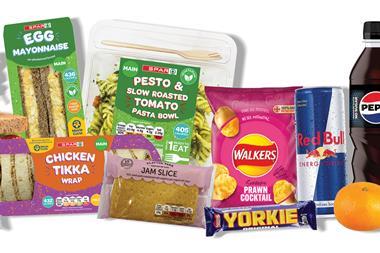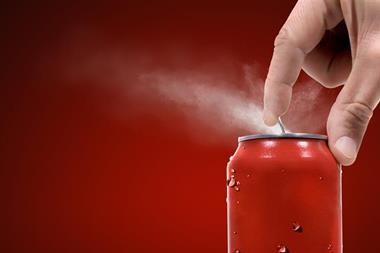The hottest story in the aisles of the recent National Convenience Show was the rise of healthy products and their potential for the convenience sector. C-Store speaks to retailers and suppliers about the must-have products appearing on health-conscious shopping lists
Feeling peckish? What do you reach for to fill the gap? Where once the obvious answer would be a chocolate bar or biscuits, today’s snackers are taking a much more scientific approach to what they consume, thanks to a seismic shift towards living healthily.
As a result, healthy snacking has become big business. The total better-for-you (BFY) market is worth nearly £125m, up 9.3% year on year (Mintel Snacks Report 2017), with more than half the population buying into the BFY category (Kantar 52 w/e 31 December 2017).
Research shows that a notable 39% of snackers say they look for a healthy product, 34% say they look for low sugar, 29% say they look for low fat and 28% look for high-protein snacks (Mintel 2018). What’s more, there’s a growing number of people snacking throughout the day, rather than eating three big meals.
“We are seeing a rise in snackification,” says Robert Rona, director of new markets, products and services at Triangle Nutrition. “So someone might have a 200-calorie noodle pot and a 200-calorie protein bar later in the day as opposed to a sandwich. This has come about from people leading busier lives and not having the time to stop and eat a full meal.”
David Knight, owner of Budgens Hassocks, West Sussex, says he’s noticed a growing interest in BFY products, and in particular a huge uplift in protein bars.
David certainly isn’t the only c-store benefitting from the protein bar boom. Between 2016 and 2017 protein bars sales were up 100% in the convenience channel, according to Charles Styles, national account manager at nutrition firm Nutramino.
C-store retailers are in an ideal position to cash in on the craze, agrees Clark Mcllroy, managing director of Red Star Brands, which distributes Fulfil protein bars. “C-stores should be perfectly placed to tap into this trend because they have the buying power for the entire store. When I speak to Tesco and the like I could speak to one of seven different buyers as they have a separate buyer for health and wellness, sports nutrition, front of store, impulse, when actually each of our products could work in each of those sections.”
To maximise the potential of the growing demand for protein bars, retailers need to be confident about merchandising the lines beyond just the health food aisle. Says Mcllroy: “As a c-store retailer, you have the power to buy the products and merchandise them wherever they’re best suited, and even site the different formats in different categories across the store.”
Juliet Barratt, chief marketing officer and co-founder of sports nutrition firm Grenade, points out that retailers should dual site the different protein products to get maximum impact. “Low- sugar or reduced-sugar options should be dual- or multi-sited. Low-sugar options that fit the free-from criteria sit in this aisle, and protein offerings with low sugar sit in specialist sports aisles. For consumers to have a real choice between traditional sugar confectionery and low- or reduced-sugar options, these products should also sit in the confectionery space.”
However, she claims that many retailers are reluctant to hand over precious confectionery space to lesser-known BFY products. “As this is a competitive aisle, built on promotions, the less-discounted and niche brands struggle to get space despite, in the case of Grenade Carb Killa Bars, having a better rate of sale. This is also the case for reduced and low-sugar protein drinks and spreads, which continue to sit in specialist aisles.”
Donna Mullan, of Mullan’s Spar in Armagh, Northern Ireland, is ahead of the curve and has been enjoying strong sales in protein bars for a couple of years. She is already putting manufacturers’ advice into play as she sites protein bars throughout her store and finds they sell well in every area.
“We sell the protein bars alongside our coffee machine. We also have them within the confectionery and the healthy foods section. In the confectionery aisle it’s almost like we’re giving people a little guilt trip as they can see the two options, a Snickers or a protein bar, and they think the protein bar would be the healthier option.”
She adds that the protein snacks have sold so well alongside her coffee-to-go that she has started to offer a drink and protein snack for £2.59.
Donna says these deals haven’t affected sales of the less-healthy products. “Despite the popularity of the protein bars, it’s not like sales of sweet things in store have dropped dramatically.”
Mcllroy agrees that it isn’t the case that protein bars are cannibalising confectionery sales, but rather that by making them more visible they could create incremental sales. He claims that two-thirds of Fulfil customers are females who were previously abstaining from treats.
Retailers need to remember that protein products can also offer higher margins than traditional confectionery, he says, providing another reason to consider them. “C-store retailers might be panicking because they are losing sales in crisps and confectionery and sugary drinks, but these protein bars offer a huge cash margin. Retailers need to sell about two-and-a-half Mars bars to make the same profit as one Fulfil bar.”
The argument for protein snacks to venture outside of the ‘healthy foods’ section and into other categories will only strengthen as time goes on, argues Liam Mahoney, account executive and nutritionist for Grenade. “I think the next thing we will see in the protein market is changes in formats as manufacturers look for ways to bring in new consumers.” He claims that new formats such as muffins and cookies are on the horizon.
Red Star Brands is developing new protein snack formats. “We’ve done a huge amount of research into our female shoppers and we’ve realised that a lot of them don’t necessarily want to eat 20 grams of protein in one hit,” says McIlroy. “We are looking into our formats as we want to provide a healthy and fulfilling snack that doesn’t leave the consumer too full.”
Another influence on shoppers’ purchasing habits is time of day. Research by Mintel has found that consumers start the day intending to be healthy, but this peters out as the day goes on (Mintel 2018 KWPO 25 March 2018 Sweets, biscuits and snacks markets). In fact, this research shows that 52% of shoppers reference health as being a key driver when purchasing snacks during the morning, but this reduces to 16% by the evening.
Gareth Hooton at Hooton’s Best-One store in Golborne, Wigan, has noticed this in his store. “The most popular protein products I sell are the Boost, Fuel and Weetabix protein drinks. I find that these products are bought by both female and male shoppers in the twenties and thirties. I notice that people tend to buy these more as a breakfast substitute more than anything else. It makes sense as protein is supposed to keep you fuller for longer so these products should ideally help keep people full till lunch.”
At the other end of the health spectrum is the trend towards “clean eating”, which refers to foods that are unprocessed or minimally processed. A sizeable 23% of shoppers want all-natural ingredients in their snacks (Mintel 2018).
According to Euromonitor International (6 February 2018), the world of health and wellness is moving towards products perceived as more natural and healthier, which has resulted in growing demand for organic, free-from and naturally healthy products globally. The free-from-gluten category showed the largest absolute growth over the review period (2012-2017), with the US, Italy and the UK being the largest contributors to this growth.
Steve Bassett, owner of Londis stores around Weymouth, has witnessed this change in his shoppers as they’ve begun picking up foods that are unadulterated. “I’ve started selling lots of plain chicken on a stick and two boiled eggs in a pot, things that I never would have thought I could sell 10 years ago. People are picking these things up because they know they are clean ingredients that provide protein without any additives.”
Rona at Triangle Nutrition agrees. “Largely, I think those brands that will succeed in the long term are those that are natural,” he says. “People are so mindful of what they are putting in their bodies and what ingredients are in the products they’re eating.”
It’s the interest in “clean” protein that has led to the growing interest in soft cheese Quark and fermented milk drink kefir.
“Kefir is 2,000 years old and it’s been big in Russia, Poland, Romania and Bulgaria,” says Jess Salamanca, marketing executive for kefir specialist Bio-tiful Dairy. “In those countries it’s like milk in the UK in that people drink it by the litre and encourage their children to drink it. We’ve only just cottoned on to it in the UK. It’s low lactose, no-added sugar, high in calcium and protein and nutritious. It’s better for you than an ordinary yogurt because it has more good bacteria for your gut and the good bacteria reaches the intestines, whereas with an ordinary yogurt the bacteria has gone by the time it’s been digested.”
Paul Gardner, owner of Budgens of Islington in London, says kefir drinks are surprisingly popular in his store. “I thought it was bizarre when I first heard about it. I mean, it’s essentially a fermented milk drink and doesn’t sound very appetising, but I tried it and really liked it and people are buying it.”
He adds that his shoppers buying products such as kefir aren’t just buying products that they think will help them lose weight; they are buying for the nutritional benefits.
Grenade’s Mahoney agrees that people are becoming more interested in how the products they consume can improve their health. He adds: “Trends to look out for could be vitamin C and D. These are the two vitamins people know the most about and as people become more interested in what goodness they’re getting from their food they could start looking for these vitamins more.”
So if you’re looking to get the most from your health products, then be sure to look out for “clean” proteins, with simple ingredients, especially those which boast multiple health benefits. And consider whether you might reap the benefits of merchandising protein bars across different categories.
Mahoney is in no doubt that this is the key to successful sales for c-stores. “Protein bars have seen a quick evolution as they are already moving into the mainstream and retailers need to start merchandising them as such,” he asserts.
McIlroy sums up: “This category is growing massively, but it’s only just scratched the surface.”
The latest developments in protein snacks

Battle stations
Protein bar company Battle Oats is vying for a place in the confectionery category with Battle Bites. Each 62g pack contains two bars, allowing consumers to eat a little now and a little later.
Battle Oats co-founder Kevin Smith explains: “Battle Bites has been developed to have the appeal of a traditional chocolate candy bar in terms of providing a tasty snack which feels indulgent, but with the bonus of being low calorie, low sugar and having nutritional benefits such as being high in protein.
“The triple-layered chocolate snacks feature low-sugar milk chocolate, meaning that they can contain up to 500% less sugar than some of the leading chocolate bars. They are just 240 calories and provide premium-quality protein so they can be enjoyed guilt-free. While some of the well-known confectionery brands have launched their own higher-protein bars, these are still very high in sugar and so don’t really provide a nutritious option.”
Smart idea
PHD has created a new Smart Jack protein flapjacks range, ideal for the convenience sector. The new bars offer 15g of protein, 229 calories and a lower price point than the average protein bar, at just £1.59.
Available in chocolate peanut, blueberry muffin and triple chocolate variants, these have been created to be more accessible due to their price point and the fact they look like ordinary flapjacks.
Deliciously on-trend
The latest product from the development kitchens of Deliciously Ella, the plant-based snack brand, is Energy Balls. Available in peanut butter, peanut butter & cacao, and peanut butter & raspberry, the new packs offer six bitesize balls of fruit and nut, as opposed to one large ball as is the case with the original range. The products are all gluten free and vegan. The energy balls have an rrp of £1.79.
Low-cal snacking
Protein Dynamix has unveiled Yumm, low-calorie snacks bags which are high in protein and under 100 calories. Available in two flavours – milk and white chocolate – these rice crispy cake-style snack packs (rrp £1.39) contain more than 20% protein (6.2g).
Trends
Meat-free is making an impact

According to the Vegan Society, there are now half a million vegans in the UK, more than three times as many as a decade ago, with almost half aged between 15 and 34.
Paul Gardner of Budgens Islington has noticed a lot of his shoppers adopting a vegan diet and thinks this is the evolving trend to watch out for over the next year. “I think vegetarianism and veganism will continue to grow. I’m going to make sure I’m better prepared for Veganuary next January as that is clearly growing in popularity.”
According to HIM, meat-free protein is one of the main current healthy shopping trends.
“The people that describe their diet as flexitarian is on the rise, as well as veganism and vegetarianism,” explains Heidi Lanschutzer, head of insight and innovation at HIM. “For a convenience store it’s all about providing choice. Keep your usual range but also provide healthy options, and when you do this look for plant-based proteins and free-from options.”
This interest in meat-free sources of protein explains the huge uplift of sales in the UK’s £100m nut butter category, which has grown by 138% over the past three years (IRI October 2017).
The same trend explains why sales of avocados increased by £29.8m and Alpro sales increased by £22.3m (14%) in the UK last year (Nielsen Scantrack 2017).
Choc-a-block with vitamins

Zoot Vitamin is a range of no-added-sugar dark chocolate bars with added vitamins and 2% naturally-occurring sugar.
There are four varieties available, with their health benefits clearly signposted on the front of packs.
Be Beautiful features vitamin E, vitamin A, Niacin and Biotin, which help maintain normal skin function and protect cells from oxidative stress.
Sunshine Boost contains vitamin D, B6 and B12 and folate. These all help with the normal functioning of the immune system, red blood cell formation and reducing tiredness.
Anti-Stress contains B-group vitamins along with valerian and hop extract. Combining hop extract & valerian has been shown to activate alpha waves which can lead to a state of relaxation.
Refresh includes vitamin E to protect cells from oxidative stress, and resVida, a high-potency trans-resveratrol, which promotes healthy ageing and a healthy heart.
All the varieties are suitable for vegetarians and vegans, and are approved by Sugarwise, the international certification authority for sugar claims.
Zoot Vitamin chocolate is packaged in 13.5g bars with 64 calories each.




























No comments yet